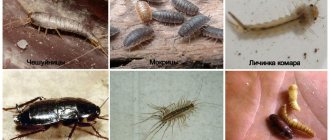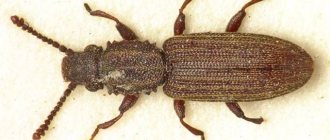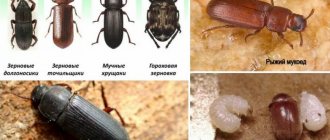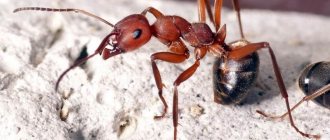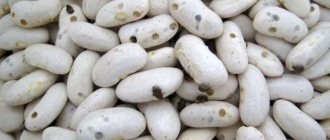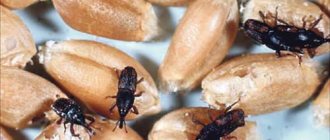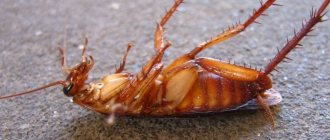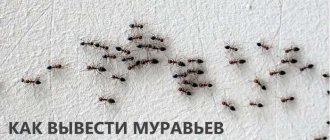Many housewives want to know how to get rid of bugs in cereals in the cupboard. The main reasons for the appearance of insects are improper organization of food storage, poor quality of raw materials or poor packaging. At the same time, some types of pests can spoil not only food, but also furniture, kitchen utensils, and towels.
Small bugs in cereals spoil the product and make it unfit for consumption. To get rid of the problem, it is necessary to eliminate its source, conduct an inventory audit and disinfect the premises
In this article, we have collected useful tips and recommendations that will help get rid of pests and also prevent their occurrence in the future.
Types of bugs
In order to destroy bugs in the kitchen, it is not enough to detect them. To get rid of them you need to determine the type of insect. The most common kitchen pests are:
- bread grinder;
- mole;
- red mucous eater;
- flour bug.
If food is infested by small brown insects that fly and eat bread and leftover buns with great pleasure, not forgetting to pay attention to the tea, then bread grinders live in the kitchen. They can get into the house along with groceries from the store. They are often found in packs of dog and cat food.
The moth looks like a faded butterfly. Its size is about 9 cm. It appears in housewives who violate the rules for storing flour and cereals. Can fly through windows and ventilation.
Mucoeds look very small, their length does not reach 3 mm. They are usually found in apartments with pets. Their favorite treats are cereals and wet, expired flour.
Flour beetles have a preference for flour and starch. Pests crawl into bags with various flours and semolina. If there are dried fruits, buckwheat and rice in the kitchen, they can crawl there too. Their distinctive feature is lightning-fast reproduction. The offspring increases every day, spreading around the room in search of new food.
Where do bugs in cereals and larvae come from?
In most cases, the insect or its larva gets in with poor quality cereals purchased by weight. However, it is not uncommon for beetle eggs to be found in vacuum packaging, if we are talking about unscrupulous manufacturers who violate the sanitary regime for storing cereals in factories and warehouses.
Infection can occur in recently purchased cereals due to improper proximity, when prunes, pasta, flour, tea, coffee, and spices are stored nearby.
Be sure to read:
How to deal with silverfish in an apartment: TOP 10 poisons and means why they are harmful to humans
How do uninvited guests appear in a living space?
You purchase kitchen pests from the store yourself. Only moths can fly in. All other insects come to their new place of residence in bags of food. If the package of cereals is transparent, then carefully study what you are going to the checkout with. In addition, new guests may appear in your kitchen from neighbors through ventilation, holes and cracks.
Causes of pests
The question of where the bugs in cereals come from leads most housewives into a dead end, since it is really difficult to understand where the insects came from in a clean, constantly cleaned room. In most cases, the appearance of bugs is not related to the housewife’s tidiness, but is often due to factors completely independent of her.
The reasons why bugs appear in cereals or flour may be as follows:
- Failure to comply with sanitary and hygienic standards in production.
- Infection of products by insects during storage or transportation.
- The introduction of beetle larvae with bakery products into the house, followed by migration of living creatures into the cereals.
Bugs cannot appear on their own in the kitchen; this must be preceded by one of the described precedents, and the housewife brings larvae into the house with purchased products, which multiply over time and infect the existing supplies.
Where are the bugs hiding?
If insects appear in the kitchen, then general cleaning is essential. We'll have to check everything. After all, kitchen pests are practically omnivorous. Neither red pepper nor medicinal herbs scare them.
Note! It is best to complete the search in one day because the bugs can multiply quickly.
The work plan is as follows:
- Sort through all the cereals. If living creatures were found in open packages, then most likely they have already gnawed through the sealed products. Open and check everything!
- Don't forget to check the salt. Perhaps the emerging insects are not connoisseurs of sweets.
- Beans are a favorite delicacy. If dark spots appear on the beans, throw them away. In the future, try to store beans only in the freezer.
- Check all the seasonings and first aid kit. Kitchen pests are partial to ordinary mustard plasters. Be sure to review all packaging.
- Don't forget about tea and coffee. A floating insect in a cup is quite a sight!
- Sort through all the vegetables. Some beetles do not disdain onions.
- Move all the furniture and check the cracks. If during this time you managed to find several clusters of beetles, you will have to check the entire apartment.
- Inspect the window sills and floors.
- Check all equipment. Don't even ignore the iron.
Prevention of insect breeding
In addition to following storage rules, in order to prevent the appearance of insects in cereals, folk tricks are often used:
- Pests are afraid of substances that have strong odors. Housewives use lavender, bay leaves, and garlic as a deterrent against cereals. Aromatic herbs and spices are placed in fabric, natural bags in cabinets, and garlic can even be placed at the bottom of a container with cereal - this will not affect the taste of the prepared dish.
- Treat containers for storing products before filling them with salted or vinegar-diluted water, followed by drying them without preliminary rinsing.
- Beetles cannot tolerate metal, according to scientists, so a small piece of foil or any metal object placed in a container with cereal will prevent pests from breeding in it.
And one more piece of advice. In order not to look for “working” methods of pest control, not to decide which of them to choose, if you need to destroy the next “offspring”, purchase products in small quantities, as needed. Agree, the risk of breeding bugs is much higher if “bulk” products are stored in bags than in situations where there are several jars of different cereals on the shelf, and it will be much easier to cope with the problem with small stocks of products.
How to quickly get rid of insects in the kitchen
Do not forget that some pests are prone to rapid reproduction. If you notice bugs in your food, clean it immediately and check the entire room step by step.
All methods of getting rid of bugs can be divided into 3 groups:
- mechanical;
- chemical;
- use of folk recipes.
Mechanical methods
- It is necessary to find all places where kitchen animals accumulate. Check all food and furniture and do a deep cleaning. Unopened packages must be opened and inspected carefully.
- Process all bulk products. To do this, pour everything one by one onto a baking sheet and heat in the oven. In cold weather, take all food out to the balcony for 5 days.
- Do some general cleaning. Clean and wash everything. Treat wooden surfaces with vinegar solution. If you used a vacuum cleaner, do not forget to process the garbage bag. It should be washed and frozen for 5 days. Insects are not afraid of household cleaning products. It is optimal to use boric acid.
- Dishes in which affected food was stored should be thrown away or washed and frozen.
- In the future, store all bulk products in airtight jars.
- Don't forget to seal any holes you find.
If few insects are found, then some products are worth trying to save. To do this, the cereals must be heated in the oven at a temperature of 100-150 degrees for 10-15 minutes or, conversely, frozen for 2-3 days.
Important! Simply pouring flour and cereal through a sieve is not enough. This will not clean the product of larvae or get rid of insects. One missed larva can give birth to another army.
Chemicals
Chemicals in the kitchen are a last resort. First, try to solve the problem using traditional methods. The most harmless chemical is pyrethrum. They need to be sprinkled where food is located. The powder is harmless to people and pets.
It is best to clean the kitchen with products containing chlorine. For best results, wipe all surfaces several times.
Antizhuk furniture impregnation is sold in specialized stores. She should treat all wooden furniture according to the instructions for use. Do not treat surfaces in direct contact with food.
Folk remedies
To combat kitchen insects, the following may be useful: vinegar, garlic, wormwood, nutmeg. The stronger the smell, the better.
You can prepare traps for beetles. On the shelves you need to lay out adhesive plaster sprinkled with garlic and other fragrant spices. You need to wipe the storage areas of cereals and other products with vinegar.
Another effective way to get rid of pests is the use of boric acid. The effectiveness of this method is that the bug does not die immediately, but manages to bring the poison to the place where its relatives gather. To prepare the trap:
- Place sheets of paper or cardboard around the kitchen.
- Mix boric acid with powdered sugar or honey.
- Place the resulting composition on sheets and leave for a couple of days.
Important! If there are children in the house, make sure that they do not eat the bait. If poison enters the baby’s body, immediately call an ambulance and rinse the child’s stomach.
Is it possible to eat grains and flour infested with beetles?
Food should not be consumed together with insects. Before using cereals, you need to get rid of pests.
However, even careful processing will not be able to remove larvae, scales, and waste products of beetles. They pose no danger to a healthy adult.
It’s a different matter when it comes to children and people with weakened immune systems. In these cases, the use of such products can cause a severe allergic reaction or cause intoxication of the human body, which will lead to disruption of the functioning of the gastrointestinal tract and an increase in body temperature.
Prevention and advice
Bugs in the kitchen spoil not only food, but also the mood of all family members. In order not to get upset in the future and not waste energy on destroying uninvited guests, it is better to carry out prevention.
5 tips on how to prevent bugs from appearing in the kitchen:
- Carefully inspect the goods you buy in stores. If the packaging is transparent, then try to see the contents through it as much as possible. Do not buy suspicious or low-quality products.
- Place all grains for storage into clean, dry, sealed containers.
- Do not keep bags of sugar and flour at home.
- Clean your kitchen regularly.
- Seal all cracks on furniture and floors.
Prevention of recurrence
There are certain preventive measures to prevent the appearance of unpleasant insects:
- Purchase products as needed. Long-term storage contributes to the appearance of pests and loss of taste.
- Use a dry, cool room to store cereals, with good ventilation.
- Storage of bulk products in glass containers with tight lids and perforated plastic bags. Linen bags and metal containers are also suitable for this purpose.
- In winter, store cereals on the balcony or loggia.
- Compliance with product expiration dates. For example, millet cereals are stored for no more than 3 months, buckwheat and rice - up to 6 months, flour and dried fruits - 1 year.
Important! If pests are found in a package of cereals, then you need to immediately check the supplies and conduct a thorough cleaning of your home. A solution of soda, salt and vinegar is suitable for this purpose.
There are no ideal ways to remove bugs. You cannot be sure of the integrity of the cereal manufacturer, even if vacuum packaging is used.
Therefore, the key to preventing the appearance of beetles is to regularly clean the kitchen area using disinfectants, inspect food supplies, and adhere to storage deadlines.
What types of “domestic” insects are there?
Representatives of about 15 species of arthropods take root in the apartments.
Mukoed Suriname
The cereal beetle loves bulk food and breeds in them. The insect is difficult to detect because its body length is only 3.5 or 4 mm. The Suriname mucoede excretes excrement into the cereal, and the product begins to rot.
After eating porridge made from buckwheat with bugs, a person suffers from an upset stomach; the husk causes allergies. The insect lives up to 3 years, during which time the female lays about 5 hundred eggs 1 mm in size. The flour beetle reproduces well at room temperature in the dark; it usually gets into the house from the store along with a bag of cereal.
Flour beetle
The insect easily crawls into cracks, where it hides eggs, from which larvae emerge. In houses and apartments, the black beetle prefers to live in the pantry or settle in drawers in the kitchen. Khrushchak insects penetrate along with bulk products and love raw cereals and wet flour.
Grinder
Miniature beetles cause enormous harm, destroying plywood and cardboard, damaging wooden furniture and walls, and gutting books. The larvae of some types of borer do not disdain:
- medicines and tobacco;
- plaster and glue;
- bakery products;
- cereals and flour.
On the chest of the insect there is a shield, when struck by it the beetle gnaws its way, making a sound reminiscent of the ticking of either a clock or an explosive device.
During the warm period, the female lays a mass of eggs in cracks, from which voracious larvae emerge and begin to eat everything they find.
food moth
A butterfly less than a centimeter in size often settles in the kitchen, where it breeds offspring, burrowing into nuts, dried fruits, and cereals. For insect reproduction, high humidity and regular ventilation of the room are sufficient. In flour, millet, buckwheat, noodles, food moths leave feces and dead larvae, and it is easy to get poisoned with such products.
See also
How to clean and how to wash the seams between tiles in the bathroom at home
Red mukoed
A small beetle with an oblong shape, it is most often found in mills, granaries, and bakeries. The insect's body is covered with villi, its hard wings are colored red. The bug breeds in high humidity and prefers to multiply in raw flour and rotten feed.
Rice weevil
An insect with bright spots on its wings, native to South Asia, quickly spread across all continents, with especially many bugs in regions with hot climates. The rice weevil feeds on cereals and does not refuse buckwheat and millet. The female insect lays eggs inside the grain, for which she gnaws holes. The beetle larvae eat all the substances, after a month they gain weight and become pupae.
Why do they start
Various insects enter the kitchen from the market, food kiosk or supermarket, where dried fruits, beans, and pasta are sold. The bugs start:
- due to improper grain processing at the enterprise;
- in case of violation of the storage conditions of the goods;
- in the absence of sanitary control of the content of cereals.
Products infested with insects are sometimes imported by unscrupulous suppliers. Bugs appear in stores when the air is too dry, there is no ventilation, or sanitary standards are not observed.
Summarizing
Remember, food is the main source of energy and nutrients for a person, and health indicators directly depend on its quality. For cooking, you should use only high-quality, usable ingredients, and cereals with components of the vital activity of food pests are far from the best option for a healthy dish.
The methods presented in the article will help you cope with pests that have conquered the territory of your kitchen, and small tricks, in the form of folk methods for preventing the breeding of beetles, will eliminate the reappearance of insects.
What kind of bugs are these?
Often, dry cereals are inhabited by small beetles, red flour beetles and bread borers.
Lesser mealworms are small, only 3-3.5 mm in size, reddish-brown beetles with short antennae, rounded sides and small wings (however, they cannot fly).
These insects enter the kitchen from brought bags of starch or flour, from where they spread throughout the entire area, crawling into cracks, latches, and loosely covered containers with dry foods. These creatures especially “respect” flour, rice, buckwheat, semolina, Artek cereals, millet and dried fruits.
Under favorable conditions, flour beetles reproduce well, producing up to four generations per year.
Products damaged by the beetleworm become lumpy and, of course, unsuitable for food. Their use is fraught with allergic reactions, stomach upset, or even poisoning.
Red flour beetles, as a rule, live in industrial enterprises - mills, bakeries, and feed mills. These are small (1.5-2.5 mm long) coleopterous insects of a rusty-yellow color, covered with small silky hairs with long, widely spaced antennae.
The taste preferences of these bugs are quite limited - flour eaters do not damage products whose moisture content is less than 15-17%; they are mainly content with rotting flour or cereals (most often corn) and dry animal feed. By gathering in groups in food, mucous beetles increase their humidity and contaminate them with excrement and shells from larvae.
A characteristic sign of the presence of a flour eater is the flour sieves it has gnawed through.
Bread borers are the most tenacious, prolific, voracious and unpretentious pests. It will take a lot of effort to get them out. These are small beetles (1.8-3.7 mm long), cylindrical in shape from light brown to red-brown in color, covered with short silky hairs.
Often in a home where grinders have infested, you can see living or dead insects on the windowsills. They love to eat dry products of animal and plant origin: various cereals, grains, tea, coffee, flour products, crackers, animal feed, cookies, dried fruits, nuts, dry medicinal plants (even poisonous ones!) and tobacco.
Traces of the presence of grinders can also be found in book bindings and herbariums, where they leave many passages, depositing the products of their vital activity in them.
The special cunning of bread grinders is that with a slight infection, their stay in the food substrate is secretive - they do not show themselves outside. But with a high population density, pests can be found on windows, walls and floors indoors.
Eating products that contain bread borers, especially without heat treatment, is harmful to health!
Effective means
Kitchen pests are immune to a variety of household chemicals - washing powders, bleaches, ammonia and chlorine-containing products.
To get rid of the scourge, you can use the cheapest and most familiar remedy - Dichlorvos. It will quickly kill all kitchen insects.
Before spraying it, keep in mind that you will have to leave the kitchen for a couple of days until the chemical wears off.
To kill beetles you need to wear a mask and glasses. All food should be taken out of the room, and containers with food should be washed and doused with boiling water before this - this will kill the larvae.
You can use folk remedies. The following seasonings will serve as reliable protection against beetles: peeled garlic cloves, bay leaf, mint chewing gum. Just put them on top of the cereal. You can put a little nutmeg on a bandage and put it in the cabinet. For the same purpose, you can use a nail or steel wire. An important point: they cannot be washed, otherwise rust will ruin the food. You can simply clean them with a dry cloth. All this is laid out not only in containers, but also on the shelves of the cabinet.
Lavender, lemon balm, citrus fruits, and mint will also help remove bugs from cereals. You need to soak a cloth in the infusions of these plants and leave it in the cabinet, where the insects presumably live
You can check whether small bugs remain after the removal procedure as follows. Plates with sunflower oil are placed on the cabinet shelf. If the insects survive, they will definitely crawl out to feast on it and drown in the liquid. You can use another bait - a mixture of borax and sugar. It is laid out on paper in a 1:1 ratio. Traps are replaced every day. Stores also sell pheramone traps that attract insects.
Is it dangerous to eat food contaminated with bugs?
If there are bugs in the cereal, you should not eat it. It is better to throw away all contaminated products or feed them to birds and animals. If such waste is beyond your means, the products must be thoroughly cleaned. It is better to sort the cereal by hand and sift the flour through a fine sieve.
After there are no visible insects left in the cereal, it must be thermally treated:
- Heat in the oven . Flour and semolina cannot withstand heating above 50°C. Other cereals can be heated to 100-110°C. Processing time – 30-40 minutes.
- To freeze. Place the sorted grains into bags and close them tightly. Place in the freezer for 2-3 days. In winter, you can put the cereal on the balcony or in the courtyard of a private house.
- Keep it in the sun. Spread the product in a thin layer on a baking sheet and place in direct sunlight for several hours.
If you plan to make porridge from the contaminated product right now, you can fill it with salted water. After some time, all the pests will float to the surface.
Important! Even if there are no adults in the croup, white larvae, scales, and insect waste products invisible to the eye will remain in it. To eat or not to eat such a product is rather a matter of disgust. However, it should not be given to young children, elderly people or those with weakened immune systems. Pest residue may cause an allergic reaction.
General cleaning as a method of pest control
Pests can also be removed by thoroughly cleaning their habitat. But subject to the obligatory condition of disposal of affected products.
What do we have to do:
- Empty the cabinet or shelf of its contents. Clean everything inside with a soapy vinegar solution. Pay special attention to food residues that often spill out in storage areas.
- Pour boiling water over all containers.
- Wash fabric bags in salt water.
- For adult individuals, it is better to use special traps.
Plants with a pungent odor also show good results in the fight against insects. These include mint, lavender, lemon balm and others. Soaking cloth strips in extracts will help prevent a new insect infestation. The main thing is not to forget to update your feeds.
